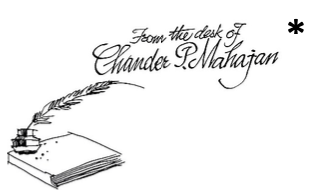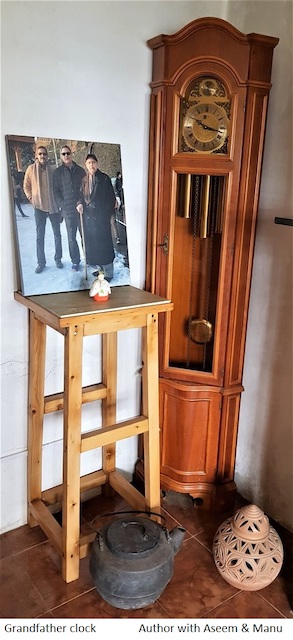
Prior to the invention of accurate clocks, sundials were the timepieces in common use. In addition to their time-telling function, sundials are valued as decorative objects, as also of mathematical study. On any given day, the Sun appears to rotate uniformly about this axis, at about 15° per hour, making a full circuit (360°) in 24 hours.
- At Garden sundial of Dehri (Rohtas), Bihar, the shadow is aligned horizontally.
- ‘Sun clock’ displayed in inlaid stone on the wall of Christ Church, Shimla is a vertical Sundial; the gnomon is the triangular blade. The style is its inclined edge.
- Perhaps, early clock-watches were not worn only for timekeeping; accuracy being of less importance. They were made as jewelry and novelties for the nobility, valued for their craftsmanship and fine ornamentation. The technical challenge was- improving accuracy and reliability.
- The invention of the mechanical clock initiated a change in timekeeping methods; driven by clockwork, powered by winding a mainspring and keeping time with an oscillating balance wheel.
- The next development in accuracy occurred with the coming up of the pendulum clock, the mechanism of a timepiece with a series of gears driven by a spring or weights came into being.
- The escapement in particular was an important factor affecting the clock’s accuracy to within a minute a day. The jewel craze caused ‘jewel inflation’ and watches with up to 100 jewels were produced.
- The first electric movements used a battery as a power source to oscillate the balance wheel. The evolution of ‘quartz watch technology’ brought in inherent accuracy and low cost of production such watches include timers, chronographs and alarm functions.
Radio Wristwatch keeps time with a quartz crystal, but is periodically synchronized to time signals transmitted from dedicated standard time radio stations or satellite navigation signals, which are set by atomic clocks capable of receiving synchronization signals from various time stations worldwide.
- Currently, atomic clocks are the most accurate clocks in existence. They are considerably more accurate than quartz clocks. This watch contains a tiny cesium atomic clock on a chip. It is reported to keep time to an accuracy of one second in 1000 years.
- All modern clocks use oscillation. Although the mechanisms they use vary, mechanical, digital and atomic, work similarly. In atomic clocks, it is the vibration of electrons in atoms as they emit microwaves.
- Smart watches of the 21st century are elaborate computer-like electronic devices designed to be worn on a wrist. These incorporate calculators, GPS and Bluetooth technology or have heart-rate monitoring capabilities, and some of them use radio clock technology to regularly correct the time.
- However, expensive* collectible watches valued more for their elaborate craftsmanship, aesthetic appeal, and glamorous design than for simple timekeeping, often have traditional mechanical movements, even though they are less accurate and more expensive than electronic ones.
- In nineties, I fixed a circular wall clock at his hired study at Dharamshala, Kangra. ‘TICK-tock TICK-tock’ -a pitched note by the ‘passing strike clock’; what a melodious resonant, echoing sound, as if from a special gong!
- I wonder if Apeem Baaba has all along been an addict to those attractive sounds; but he is a great collector. Though it is difficult to gauge, yet a few pieces are exclusive.
- Men wore watches with chains up in pockets until the early-20th century. An ‘Opened-up pocket watch’ brought home from England by my uncle after passing out as an Electrical Engineer, now adorns Apeem Baa’s collections. The British maintained high-quality products for the elite, though the plaque of the watch reads Genève.
- The anniversary clock -a 400-day clock is a spring-wound mantel clock. A decorative wheel with 3 or 4 chrome balls on ornate spokes, suspended by a thin wire called a torsion spring. The torsion pendulum oscillates slowly, clockwise and counterclockwise; exposed under a glass dome. It was last corrected by Mr. Suresh Kumar from the ‘Phool Chand dynasty, the only expert available in Shimla. We had to import- Horolovar 400- day Clock Pendulum Suspension Springs from Lancaster, U K.
- Pendulums are used to regulate the movement of clocks because the interval of time for each complete oscillation, called the period, is constant. Mechanical clocks must be wound periodically, usually by turning a knob or key or by pulling on the free end of the chain, to store energy in the weight or spring to keep the clock running.
- The longcase clock (grandfather clock) houses the pendulum. The clock case is made of wood and clock face is a ceramic-like beautiful material.
In the latest trends, Apple’s next-generation smartwatch, likely to be called Apple Watch 7, was recently tipped to feature a new sensor to monitor blood sugar levels.
Only a few days back, an Apple Watch was used to stabilise a premature baby born on a Hawaii-bound flight.
“We should wear something that personifies us and what we like”
………………………………………………………………………………………………………………………………
* The most expensive watch ever sold at auction worldwide is the Patek Philippe Grandmaster Chime Ref. 6300A-010, which fetched 31.19 million US dollars (31,000,000 CHF) in Geneva on November 9, 2019 (by Christie’s).
Prof. (Er.) Chander P Mahajan is an art critic & a free lance journalist. The Environmentalist stays in Shimla and Dalhousie, Himachal Pradesh, India.





 Radio Wristwatch keeps time with a quartz crystal, but is periodically synchronized to time signals transmitted from dedicated standard time radio stations or satellite navigation signals, which are set by atomic clocks capable of receiving synchronization signals from various time stations worldwide.
Radio Wristwatch keeps time with a quartz crystal, but is periodically synchronized to time signals transmitted from dedicated standard time radio stations or satellite navigation signals, which are set by atomic clocks capable of receiving synchronization signals from various time stations worldwide.


